MCAT Organic Chemistry - Separations and Purifications
1/54
Name | Mastery | Learn | Test | Matching | Spaced |
|---|
No study sessions yet.
55 Terms
extraction
transfer of a dissolved compound (the desired product) from a starting solvent into an immiscible solvent in which the product is more soluble
Like dissolves like
polar substances will associate with other polar substances, and nonpolar with nonpolar
immiscible
fluids that do not dissolve in the other and instead form two layers that do not mix,
ex. water and oil
aqueous phase (layer)
contains water and other polar or charged compounds
organic phase (layer)
contains oils and other nonpolar or uncharged compounds
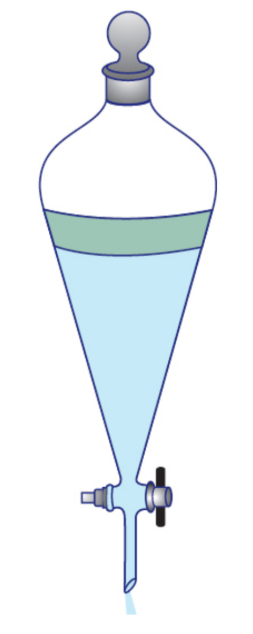
separatory funnel
special tool for extraction; gravitational forces cause the denser layer to sink to the bottom of the funnel, where it can then be removed by turning the stopcock at the bottom
three intermolecular forces that affect solubility
Hydrogen bonding: Compounds that can do this, such as alcohols or acids, will move most easily into the aqueous layer
Dipole–dipole interactions: These compounds are less likely to move into the aqueous layer
Van der Waals (London) forces: With only these interactions, compounds are least likely to move into the aqueous layer
acid-base extraction
move the desired compound into a different phase using acid-base chemistry
rotary evaporator (rotovap)
evaporates the solvent to isolate the desired product
wash
reverse of extraction; small amount of solvent is used to extract and remove impurities, rather than the compound of interest
Filtration
isolates a solid from a liquid; pour a liquid–solid mixture onto a filter that allows only the solvent to pass through
residue
solid of filtration
filtrate
liquid that passed through the filter
Gravity filtration
the solvent’s own weight pulls it through the filter; more commonly used when the product of interest is in the filtrate
hot filtration
type of gravity filtration where the solvent is kept hot to keep the desired compound dissolved; product of interest is in the filtrate
Vacuum filtration
the solvent is forced through the filter by a vacuum connected to the flask; more often used when the solid is the desired product
Recrystallization
method for further purifying crystals in solution; dissolve product in a minimum amount of hot solvent and let it recrystallize as it cools; solvent chosen one in which the product is soluble only at high temperatures so it will precipitate out as the solvent cools
Distillation
separate two liquids by evaporation and condensation; liquid with the lower boiling point will vaporize first, and the vapors will rise up the distillation column to condense in a water-cooled condenser; heating temperature is kept low so that the liquid with the higher boiling point will not be able to boil and therefore will remain liquid in the initial container
condensate
evaporated and cooled liquid from distillation on the condenser
distillate
end product of distillation
Simple distillation
least complex version of distillation; used to separate liquids that boil below 150°C and have at least a 25°C difference in boiling points
distilling flask
contains the combined liquid solution
distillation column
consists of a thermometer and a condenser
condenser
heat exchanger used to condense a gaseous substance into a liquid state through cooling
receiving flask
collects the distillate
Superheating
occurs when a liquid is heated to a temperature above its boiling point without vaporization; gas bubbles within a liquid are unable to overcome the combination of atmospheric pressure and surface tension
can be prevented using boiling chip, ebulliator, or magnetic stirrer
vacuum distillation
distill a liquid with a boiling point over 150°C; lower the ambient pressure, thereby decreasing the temperature that the liquid must reach in order to have sufficient vapor pressure to boil without degrading the product
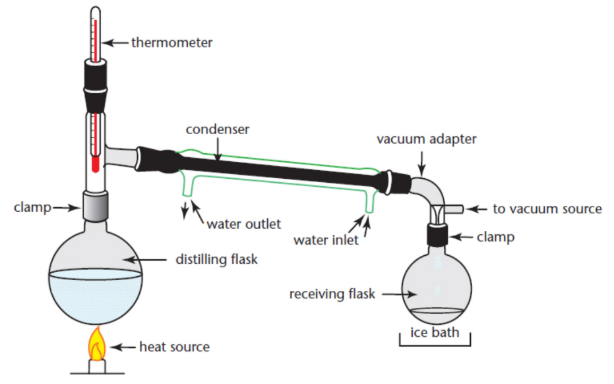
fractional distillation
separate two liquids with similar boiling points; less than 25°C apart; fractionation column connects the distillation flask to the condenser
fractionation column
a column in which the surface area is increased by the inclusion of inert objects like glass beads or steel wool; lower boiling point heated to stay vapour; only the desired product drips down to the receiving flask
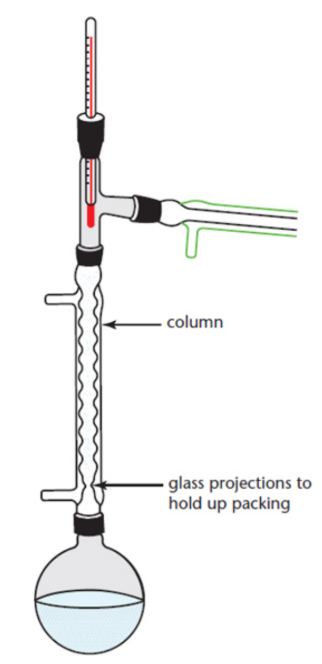
Chromatography
uses physical and chemical properties to separate and identify compounds from a complex mixture; the more similar a compound is to its surroundings (whether by polarity, charge, or other characteristics), the more it will stick to and move slowly through its surroundings
stationary phase / adsorbent
solid medium onto which the chromatogrpahy sample is placed
mobile phase
fluid that is flowed through the stationary phase and carries the sample
elute
displace the sample out of a mixture through chromatography
partitioning
different substances adhere to the stationary phase with differing strengths, causing the different substances to migrate at different speeds; results in separation withinthe stationary phase
partitioning coefficients
unique to each compound; dictates elution rate
thin-layer chromatography
adsorbent = silica/alumina (polar and hydrophilic) adherent on carrier sheet, mobile phase = organic solvent of weak to moderate polarity; solvent will creep up the plate by capillary action, bringing sample with it; more nonpolar the sample is, the further up the plate it will move
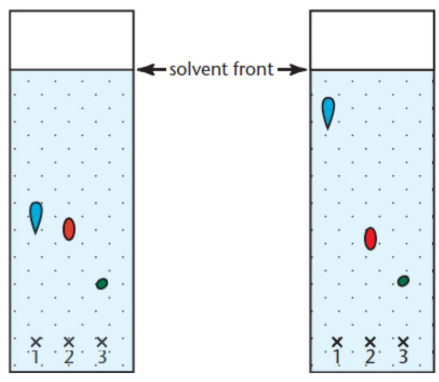
paper chromatography
adsorbent = paper (cellulose); solvent will creep up the plate by capillary action, bringing sample with it
spotting
small, well-defined spot of the sample directly onto the silica or paper plate
development
placing the adsorbent upright in a developing chamber, usually a beaker with a lid or a wide-mouthed jar
eluent
solvent system used in chromatography
Reverse-phase chromatography
stationary phase used is nonpolar, so polar molecules move up the plate quickly, while nonpolar molecules stick more tightly to the stationary phase
retardation/retention factor (Rf)
calculated value of relative polarity; relatively constant for a particular compound in a given solvent
Rf = distance of spot / distance of solvent front
ultraviolet light development
many compounds are colorless to the naked eye, so the developed plate can be placed under ultraviolet light, which will show any compounds that are UV-sensitive
TLC stains
shows the compunds on the stationary phase, but destroys the compounds such that they cannot be recovered
ex. iodine, phosphomolybdic acid, vanillin
preparative TLC
larger scale TLC as a means of purification; large plate develops, the larger spot of sample splits into bands of individual compounds, which can then be scraped off and washed to yield pure compounds
column chromatography
uses an entire column filled with silica or aluminum beads as an adsorbent, allowing for much greater separation; uses gravity to move the solvent and compounds down the column; solvent polarity can also be changed to help elute the desired compound
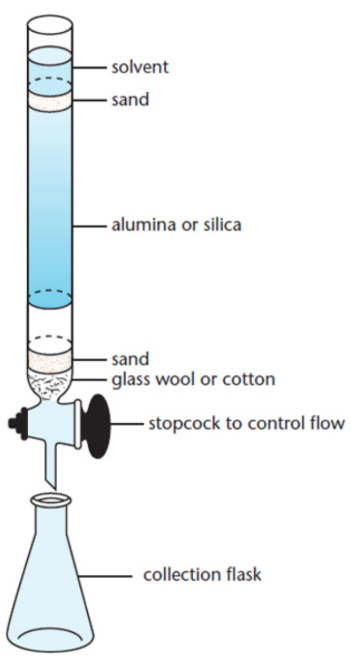
flash column chromatography
force the solvent through the column using gas pressure
ion-exchange chromatography
beads in the column are coated with charged substances so that they attract or bind compounds that have an opposite charge; after all other compounds have moved through the column, a salt gradient is used to elute the charged molecules that have stuck to the column
size-exclusion chromatography
beads used in the column contain tiny pores of varying sizes that allow small compounds to enter the beads, thus slowing them down
affinity chromatography
protein of interest is bound by creating a column with high affinity for that protein; Once the protein is retained in the column, it can be eluted by washing the column with a free receptor (or target or antibody), which will compete with the bead-bound receptor and ultimately free the protein from the column; Eluents can also be created with a varying pH or salinity level that disrupts the bonds between the ligand and the protein of interest
ex. nickel (attracts histidine)
Gas chromatography (GC) / vapor-phase chromatography (VPC)
method that can be used for qualitative separation; eluent is a gas (usually helium or nitrogen) instead of a liquid; adsorbent is a crushed metal or polymer inside a 30-foot coiled column in an oven; gaseous compounds travel through the column at different rates because they adhere to the adsorbent in the column to different degrees and will separate in space by the time they reach the end of the column
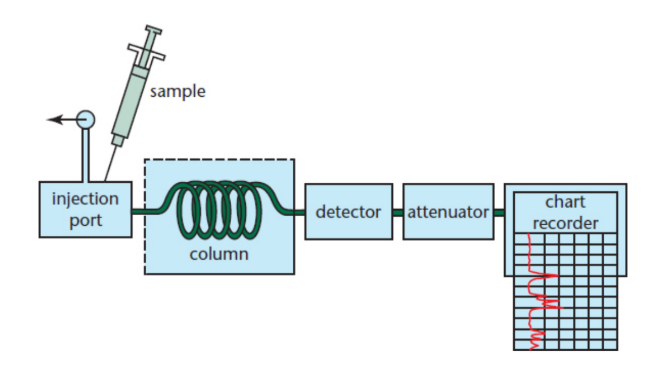
volatile
low melting-point, sublimable solids or vaporizable liquids
Mass spectrometry
involves the ionization and fragmentation of compounds; these fragments are then run through a magnetic field, which separates them by mass-to-charge ratio. e total molecular weight can thus be determined, or the relative concentrations of the different fragments can be calculated and compared against reference values to identify the compound
mass spectrometer
tool for mass spectrometry
High-performance liquid chromatography (HPLC)
eluent is a liquid and travels through a column of a defined composition; small sample is injected into the column, and separation occurs as it flows through a detector and is collected as the solvent flows out of the end of the apparatus; sophisticated solvent gradients as well as temperature can be applied to the column to help resolve the various compounds in the sample